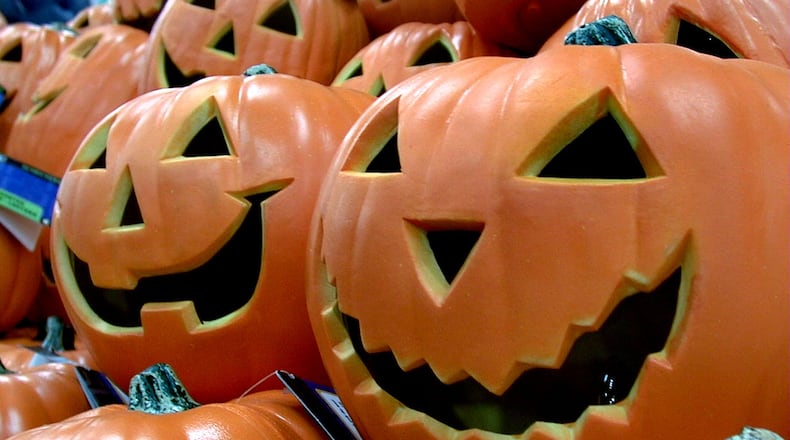Halloween is one of the most anticipated holidays of the year. Dressing up, carving pumpkins, eating chocolates and other treats are all part of the fun.
But it’s also an evening full of safety hazards — everything from benign tummy aches to tripping over costumes or on poorly lit sidewalks to getting hit by cars.
This year, Halloween falls on a Monday, but it’s a special night and kids will be walking around outside more than usual. More caution is needed as families with little trick-or-treaters and eager partygoers may hit the streets at the same time, some on foot, and others in cars.
Children are twice as likely to be hit by a car and killed on Halloween as on any other day of the year, according to Safe Kids Worldwide, a global organization committed to preventing accidental childhood injury.
Halloween is a particularly deadly night because of the high number of drunken drivers on the roads mixed with the increased number of people on foot. In fact, over the five years from 2007 to 2011, 23 percent of pedestrian fatalities on Halloween night involved a drunken driver, according to the National Highway Traffic Safety Administration. (The NHTSA urges people who may drink alcohol to designate a sober driver to get home safely or consider a taxi or Uber ride home.)
Experts say planning ahead and remaining vigilant are the keys to a safe holiday.
Dr. Vivian Lennon, medical director for primary care services at Children's Healthcare of Atlanta, said there's no reason to be overly anxious about safety concerns, but instead parents should be creative and think about safety in a way "that's fun for our kids."
Lennon recommends parents start with a review of the costume choices, making sure costumes aren’t too large or flowing so kids won’t trip. She also suggests adding reflective tape — which costs pennies at a hardware store — to any part of the costume, even on the backside of the costume.
A big fan of glow sticks, Lennon said they can be worn as necklaces, bracelets, even around the ankles. Lennon, who is a mother to two boys, ages 11 and 14, buys them in bulk at the Dollar Store and gives them to her kids to share with friends.
For older kids who may be lukewarm to glow sticks, she suggests flashlights, which will not only help them see in the dark, but also help them be seen by drivers.
The expected increase in the number of cars on the road this Halloween — especially after 9 or 10 p.m. when adults are going to or returning from parties — is Lennon’s biggest concern. While younger trick-or-treaters will likely be home by then, older ones, some of whom may not have parental supervision, may still be out. Parents of older trick-or-treaters should remind them about the importance of crossing at intersections, looking both ways and waiting for cars to pass. Trick-or-treaters should stay on sidewalks whenever possible, and walk facing the oncoming traffic.
Atlanta-based Safe Kids Georgia and Children’s Healthcare offer the following tips for Halloween:
Avoid costumes with excessive flowing fabric, such as capes or sleeves. Loose clothing can brush up against a jack-o'-lantern or open flame. Oversized costumes can cause trips and falls.
If possible, choose a brightly colored costume that drivers can spot easily. If not, decorate the costume with reflective tape and stickers. Glow sticks and flashlights are also good accessories.
Choose face paint and makeup whenever possible instead of masks, which can obstruct vision. If a mask is worn, be certain it fits securely and cut the eye holes large.
Inspect the treats. Toss anything tampered with or that has loose wrappers or doesn't seem right. Also toss anything homemade — unless you know the person who gave it to your child and can be sure it's safe.
Always supervise children under the age of 13. Older children should trick-or-treat in a group, and a curfew should be established. Older kids should go in a group — never alone. Create a route ahead of time.
Walk slowly. Be mindful about cars, making eye contact with drivers. Always walk on sidewalks and cross at crosswalks or traffic signals. If there are no sidewalks, then walk facing traffic and way to the left.
Tell your child to go only to well-lit houses and remain on the porch within street view. Make sure your child understands never to cross between parked cars and to look both ways before crossing.
Drivers should back out slowly, keeping a watchful eye on children and knowing that high times for trick-or-treating are from 5:30-9:30 p.m. No distracted driving.
More: Georgia pumpkin patches and corn mazes offer fall fun
More: Vote: What’s the worst Halloween candy?
More: Your guide to Taste of Atlanta: Tickets, events and more
About the Author
Keep Reading
The Latest
Featured


